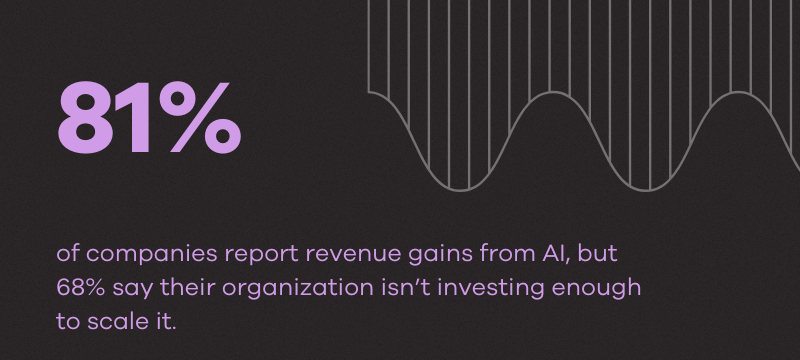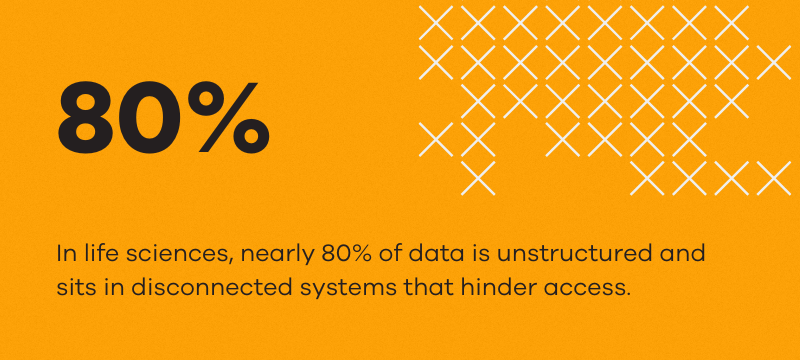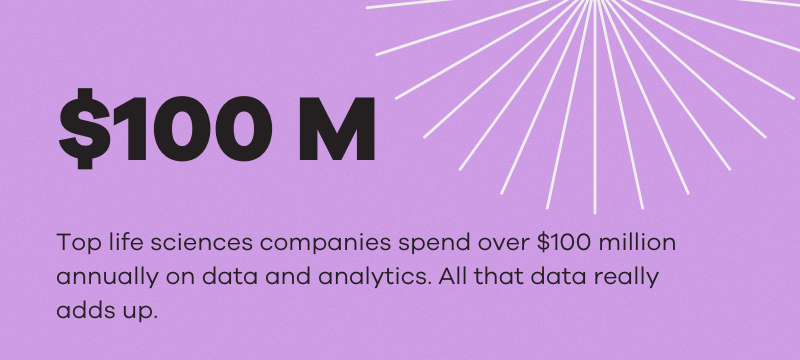AI is opening new doors in life sciences. From accelerating drug discovery to supporting personalized medicine, what used to take years is now happening in months.
It’s an exciting time for AI in life sciences. Generative models are helping reduce drug development time and cost by up to 50%.Plus, AI-driven simulations are cutting early-phase trial timelines by as much as 30%. At Oxford, researchers use an AI tool called VNE to enhance MRI scans without contrast dye, cutting scan time by up to 66%.
But the road to adoption isn’t easy. Compliance risks, legacy systems, and federal budget cuts make moving forward harder, even as the pressure to deliver keeps growing.
Let’s examine what’s hindering AI adoption and how AI enablement for life sciences helps teams overcome it.
What Is AI Enablement in Life Sciences?
AI enablement for life sciences builds the foundation for generative AI to deliver meaningful results. That means:
- Pulling together data from labs, trials, and real-world sources
- Automating how data is cleaned, organized, and protected
- Building in compliance from the start
Life sciences depend on data, so teams need AI to move forward. But without proper enablement, projects slow down and risks add up. Remember, generative AI in life sciences is only as good as the data, systems, and safeguards behind it.
Why AI Adoption Still Struggles in Life Sciences

AI in life sciences is progressing, but there’s still room to grow. While NVIDIA found that 81% of companies report revenue gains from AI, 68% say their organization isn’t investing enough to scale it.
While that’s starting to change, the gap points to deeper issues. Many teams shy away from AI because they’re not equipped to handle it. Even with strong AI use cases in life sciences, organizations face a long list of blockers that are getting in the way of progress.
Compliance can be a bottleneck
In life sciences, data protection and compliance go hand in hand. Teams work with sensitive and high-stakes personal health data every day. That means keeping up with strict and shifting standards like HIPAA, GDPR, and GxP, as well as state-level laws like the My Health My Data Act in Washington.
At the same time, the data on life sciences keeps growing. While more access often leads to better outcomes, it also raises risk. For instance, AI in the pharmaceutical industry usually relies on real-world patient data, which requires consent, anonymization, and full audit trails to stay compliant.
AI adds to the pressure. Tools like generative AI for life sciences introduce risks, like data leakage, bias, and hallucinations. These aren’t just technical issues. They can lead to a real loss of trust and regulatory violations.
One slip in consent or access can cause severe legal and reputational damage for life sciences teams. And as the risks grow, so do the regulatory demands:
- The EU AI Act and ISO 42001 label many AI tools as “high-risk.”
- FDA guidance requires full traceability, validation, and oversight.
On top of that, life sciences organizations often work with a mix of research partners, vendors, and regional teams. Each brings its own compliance requirements; meeting these standards isn’t easy.
Legacy systems don’t talk to each other
Legacy systems may have worked in the past, but they weren’t built for AI. Most don’t connect with newer tools or support the data flow AI needs, creating blind spots teams can’t afford to ignore.
When systems don’t sync, no one knows who accessed what or where data is stored. That lack of visibility creates real risk in life sciences. One missed access point, like an outdated imaging system or a forgotten PDF archive, can expose sensitive information. It also means:
- Slower response times during security incidents
- More effort is required to meet today’s compliance standards
Patients, clinicians, and researchers expect data to be secure and accessible. That trust breaks down when tools don’t connect. For example, one research company faced a malware attack after a phishing email slipped through. Because their systems weren’t linked, tracing the breach and containing the damage took longer.
Data is unstructured and scattered

In life sciences, nearly 80% of data is unstructured. It comes from lab notes, imaging systems, wearables, and devices, all in different formats. That makes it hard to connect or analyze. As a result, the search for life sciences data is slow and unreliable. Most of it sits in disconnected systems, buried in silos that teams can’t easily access.
Researchers spend hours trying to organize data instead of acting on it. Unsurprisingly, 52% of R&D leaders say integration is one of the most significant barriers to digital transformation. Critical insights stay buried when systems don’t talk to each other, and progress slows down.
AI in pharmaceutical, biotech, and medical devices needs clean, connected data. Without it, models miss key insights and slow teams down.
Manual work delays progress
Manual data entry and cleanup still dominate many workflows in life sciences. These tasks have become a significant time sink, slowing research and introducing errors.
87% of scientists say they carry the burden of keeping complex experiments together. Half say the most significant barrier to using automation tools is the time it takes to get them up and running. Until that changes, manual work will continue to hold teams back in life sciences.
Data is expensive to manage

The life sciences industry generates thousands of terabytes of data every day. Storing, securing, and managing that volume, especially across cloud platforms and collaborative tools, is costly.
Top life sciences companies spend over $100 million annually on data and analytics. And as data continues to grow, so do the demands on IT and research teams to keep it accessible, secure, and audit-ready.
Policy Shifts Are Raising the Pressure
Life sciences teams are running into more red tape. Funding is shrinking, supply costs are climbing, and reviews are taking longer. At the same time, teams are expected to move faster and deliver more.
NIH’s 2026 budget faces an $18 billion cut, about 40% lower than last year. Over 4,400 grants are now at risk, and over 1,000 have already been canceled or delayed.
Labs are scaling back, projects are stalling, and early-career researchers are in limbo. Tariffs and supply chain rules also drive up the cost of lab equipment and materials, especially for smaller labs. Meanwhile, federal staff cuts are slowing down approvals and reviews. Many teams don’t know if their funding is late or gone for good.
Gartner reports that these issues are only growing. Rapid policy changes and limited resources force life sciences teams to make faster decisions with less room for error. Two of the biggest challenges include:
- Slower reviews are holding up progress: Layoffs at the FDA, CDC, and NIH have dragged out approval timelines, inspections, and key regulatory guidance.
- Surprise policy changes are straining planning: “Effective immediately” rules make it harder for teams to stay compliant and keep clinical trials running smoothly.
However, while most policies are tightening, AI is getting the green light. Executive orders are clearing the way for the rapid adoption of AI in life sciences.
That’s pushing research teams to lean on AI. With fewer checks, adoption is moving faster, but so are the risks. Companies now carry more of the weight when it comes to safety, transparency, and accountability. Teams can’t afford to fall behind, as AI tools become part of everyday clinical and admin work.
How Life Sciences Teams Get AI Projects Off the Ground
Life sciences teams need a setup that meets them where they are. It starts with connecting systems, cleaning up the data, and ensuring it flows into the right tools. Here’s how to make that happen with AI enablement for life sciences.
Access
It isn’t realistic to replace the tools life sciences teams already use. It makes more sense to connect what’s already in place.
BA Insight’s AI Enablement Platform makes that possible. It connects to over 95 systems, including leading Life Sciences platforms like Veeva Vault, and handles fragmented setups without needing custom builds. Teams can pull in data from multiple sources, structured and unstructured, without slowing down day-to-day operations.
Prepare
From there, teams need data that AI can use. That means clean, organized, and compliant inputs. Automating this step helps teams move faster and maintain accuracy along the way.
That’s why life sciences teams use BA Insight’s AutoClassifier. It enriches and augments, fills in missing details, and applies the right formats to meet standards like HIPAA and GxP. It builds a stronger data foundation and helps AI models run with fewer errors and hallucinations by:
- Organizing messy or incomplete data
- Applying the right formats automatically for compliance
- Optimizing enterprise knowledge so AI can use it at scale
With clean, structured data from the start, teams can trust their AI to deliver more reliable results.
Deliver
Once the data is ready, it must move into your team’s tools. That might be an internal model, a cloud platform, or a mix of both.
Some enterprises get stuck here. Inflexible solutions may not let you bring your models or switch engines later. That kind of lock-in limits how well AI can support the full scope of your needs.
BA Insight’s AI Enablement Platform is built for flexibility. It supports on-prem connectors, hybrid environments, and full cloud deployments. That matters for highly regulated industries like life sciences, where compliance often requires tighter control. You can bring your models, plug into existing systems, and switch technologies as your stack evolves.
The platform also helps you stay in control by:
- Securing sensitive data with built-in access controls
- Providing full audit logs to track how AI is used across the organization
With a modular foundation, your AI can adapt as your needs grow.
How to Get More from AI in Life Sciences
The ground is shifting under life sciences. According to PwC, the old blockbuster model, mass-produced drugs for broad populations, gives way to personalized, precision-based treatments.
That means tighter margins, smaller patient groups, and higher speed, accuracy, and compliance demands. And with public funding drying up, teams need more support than ever. AI simply can’t deliver what it promises without the right systems in place.
BA Insight’s AI Enablement Platform offers a solution. If you’re exploring AI or considering a Sinequa alternative, the right experts can steer you through challenges like compliance, connectivity, and funding changes.
AI is redefining life sciences, and understanding how AI enablement powers and frees your researchers can drive smarter strategies, future success, and better patient outcomes. Reach out to learn more about AI enablement for life sciences.


